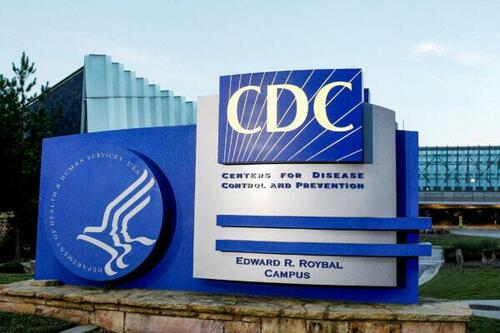(On dit quoi, cela est la conséquence d'un gouvernement par les multinationales ? A qui la faute, au système de financement des campagnes électorales américaines qui font des élus de simples pions des intérêts qui l'ont financé. note de rené)
Nearly Half Of All Americans Now Have A Chronic Disease
Authored by Autumn Spredemann via The Epoch Times (emphasis ours),
It can strike at any time and at any age. When someone develops a chronic disease, it can cause debilitating, life-altering changes that penetrate every aspect of daily life.

The prevalence of these conditions has surged over the past decade, creating a twofold health care and economic crisis affecting nearly half of Americans. By 2030, the number of U.S. residents struggling with at least one chronic illness is expected to surpass 170 million.
That’s more than half of the entire country, for perspective.
The expanding elderly population and adults aren’t the only age groups seeing an uptick. More than 40 percent of children and adolescents currently have at least one chronic illness, according to the Centers for Disease Control and Prevention (CDC).
There’s also a tremendous cost burden. The spectrum of chronic diseases comprises a disproportionately large segment of U.S. health care costs. Of the nation’s $4.1 trillion annual health care expenditures, chronic diseases account for 90 percent.
That’s more than $3 trillion dollars of annual direct costs alone.
At an individual level, the price tag doesn’t look any better. Estimates for the treatment and management of chronic conditions—on average—tally more than $6,000 annually per patient.
Some chronic disease specialists and health practitioners say that figure is spot on, depending on the condition.
Beyond the Numbers
“For example, if you have type 2 diabetes, you are often checking in with your provider every three months. Four visits a year, times $300 a visit, plus the amount spent for medications per month … quickly adds up,” nurse practitioner Lola MacLean told The Epoch Times.
MacLean has worked in family and internal medicine for the past five years. In that time, she’s noticed a spike in the number of patients suffering from chronic conditions walk through the door.
“I have seen an uptick in chronic conditions, especially those related to metabolic disorders, [like] type 2 diabetes, hypertension, hyperlipidemia, and mental health conditions such as anxiety and depression,” she said.
Many chronic diseases require specialist care for management. Providers in these fields have also witnessed a surge in patients.
“Indeed, I have noticed an uptick in the number of patients with chronic diseases, particularly those with respiratory diseases such as asthma and COPD [Chronic obstructive pulmonary disease],” John Landry told The Epoch Times.
Landry is a licensed, registered respiratory therapist and founder of the education platform Respiratory Therapy Zone. He noted chronic respiratory diseases often require expensive medications, frequent doctor visits, and hospitalizations.
“I find the estimate of $6,000 USD for the annual cost of treating chronic diseases to be plausible … This doesn’t even take into account indirect costs such as time off work for the patient and their caregivers.”
Landry says it’s important to remember that doctor’s visits and prescriptions aren’t the only factors in the final bill.
“Chronic illnesses often result in loss of work productivity which indirectly increases the financial burden.”
Conditions with some of the highest direct health care costs in the United States are diabetes at $189.6 billion in annual expenses, Alzheimer’s disease at $185.9 billion, and osteoarthritis at $115.5 billion.
But the price of living with a chronic disease goes beyond dollars and cents. For many, it’s a daily battle that demands vigilance, patience, and emotional support.
Uphill Battle
For Deb Borchert, a trip to the hospital is almost as routine as folding laundry. The 47-year-old Wisconsin mother of two knows most of the emergency room staff at her local hospital by their first names.
On March 10, she arrived at the emergency room with her miniature medical assistance dog, Molly. Her specialist’s phone number was already on file, and she was promptly admitted for treatment without delay.
There was no red tape or extra paperwork. Borchert was put in a bed and hooked up to IVs and machines that would help save her life.
Because despite her outwardly calm demeanor, she was on the threshold of cardiac arrest. Again.
“Your pulse oxygen drops, and your entire body just collapses. It can’t even function,” Borchert told The Epoch Times.
She suffers from a condition known as hypokalemic periodic paralysis, which causes consistently low and dangerous potassium levels. It’s an illness that has landed her in the hospital more times than she can count over the past 20 years.
For most people, healthy potassium levels are between 3.5 and 5.2. Anything below 2.5 is considered a life-threatening condition.
Borchert was admitted on March 10 with a potassium level of 2.2.
“I’ve had it since my 20s, but they’ve never known how to really treat it. Every time, they try different drugs, but I’m allergic to a lot of those,” she said.
It’s a tune heard often among those suffering from chronic diseases. Lengthy, exhausting, and a sometimes dangerous trial-and-error process with treatment. Some conditions can also be difficult to manage with traditional Western medicine.
This is the case for Julie Walters, whose 14-year-old daughter suffers from a rare form of epilepsy called PCDH19, which is caused by a gene mutation. It’s also challenging to manage with medication.
Moreover, it causes intense clusters of seizures that can stop someone’s breathing. It’s a side effect her daughter has endured many times and, as a result, Walters’ daughter sleeps with a pulse oximeter and supplemental oxygen nearby.
“It’s changed our entire lives,” Walters told The Epoch Times.
Walters is co-founder of the PCDH19 Alliance, an online support network promoting early diagnosis and supporting families struggling with the condition. She also runs The Connected Parent, which is a free platform for families and caregivers that also reviews resources.
Walters is acutely aware of how important resources are for parents who have children struggling with PCDH19 and other chronic diseases.
Her daughter’s illness requires constant monitoring and vigilance. Family vacations, attending school, or just going out to dinner must be planned carefully since her daughter might have a seizure at any moment.
Things like sharp corners on furniture, balcony seating, and other details most people don’t give much thought to are an act of strategy and planning in Walters’ household.
But it’s absolutely worth it to watch her daughter grow and enjoy as good a quality of life as possible.
Many PCDH19 patients can go years without a seizure. Yet when they return, it can be harrowing. She recalled a nightmare episode when her daughter suffered a seizure that lasted for over an hour, requiring hospitalization.
“It’s something you’re always thinking about,” Walters admits.
Cause and Effect
Borchert and Walters battle conditions beyond their control, but health care professionals say some chronic diseases are the byproduct of unhealthy lifestyle choices, diet, and excessive stress.
One study asserts that non-communicable diseases that are chronic account for 70 percent of all global deaths annually. That includes various ailments and severity, from food allergies to heart disease.
Some of these conditions are called “lifestyle diseases,” many of which have an established cause-effect relationship with daily choices.
Heart disease and obesity fall under this heading. And while certain illnesses may not stem directly from unhealthy life choices, they’re made significantly worse by them. Diseases like diabetes, certain cancers, inflammatory conditions, and asthma are all under this umbrella.
“The vast majority of chronic diseases in the United States are related to lifestyle choices, and contributing factors include dietary choices, lack of regular physical activity, [and] mental-emotional stress,” MacLean said.
The CDC says the main factors contributing to this subset of “lifestyle diseases” include tobacco use, poor nutrition, being overly sedentary, and excessive alcohol usage.
But beyond the price tags and life hurdles, chronic diseases remain the biggest killers in the United States. They claim the lives of 7 out of 10 Americans every year.
Further, the tidal wave of chronic diseases has occurred in lockstep with a sharp rise in ultra-processed food consumption over the past two decades.
An 18-year study published by New York University showed that consumption of ultra-processed food climbed steadily during this period and comprised 57 percent of America’s daily calories by 2018.
During that study period, an additional 15 million people developed chronic diseases. Medical professionals say this is no coincidence.
Yet a more subtle shift from acute to chronic illnesses as the dominant U.S. health concern began in the 1950s. Some researchers place the blame for the current health crisis squarely on the shoulders of a lethargic medical industry.
A 2020 study published in the National Library of Medicine summarized, “The medical profession and its leadership did not recognize or respond appropriately to the rising prevalence of chronic disease. As a consequence, a health care crisis emerged, with inadequate access to care and quality of care, together with excessive costs.”
Finding Hope
“It’s taken away my ability to do whatever I want and enjoy the best of what life has to offer,” Borchert said.
Though her condition has also given her a different perspective on life. She says you’d never know how sick she was at a glance or even during a normal conversation on her good days.
This is the case for many, including Walters’ daughter. Chronic illness is a constant battle with an invisible enemy that, for some, has no end in sight.
But this is where Borchert found a surprising and important new mission: spreading kindness.
“What’s most important is kindness and giving back. If I see someone struggling or having a rough day, I’ll do something nice. I’ll pay for their groceries if I’m ahead of them in line or buy their coffee,” she said.
Over the past two decades, Borchert watched her son and daughter grow into responsible adults, which inspired her to be a better person. The loss of so many little freedoms through the veil of her disease has given her an appreciation for the little things.
“When I was younger, I used to take those things for granted. I don’t want to be like that anymore. It’s made me more kind, more empathetic. There are so many chronic illnesses you can’t see.”
For Walters, her fellow “medical moms” have been a critical lifeline in her family’s journey. Because it takes a proverbial “village” to tackle chronic disease, especially when there’s no cure.
“Community, friendships, and the alliance. My daughter has friends with the same mutation, and they chat every weekend,” she said.
“A lot of the families have created these friendships … because they get it.”

Aucun commentaire:
Enregistrer un commentaire